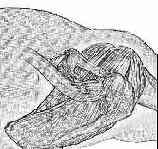- See:

- massive rotator cuff tear - disscussion
- shoulder hemiarthroplasty
- Discussion:
- by definition, a massive RTC tear invovles tears of more than 5 cm and involves more than than one tendon;
- further, massive tears cannot be repaired w/o excessive tension after lysis cuff adhesions and release of the coracohumeral ligament; (see cuff mobilization)
- Hemiarthroplasty in the Rototar Cuff Deficient Patient:
- shoulder hemiarthroplasty:
- in cases of massive rotator cuff tears, glenohumeral arthritis may develop (cuff tear arthropathy) but the exact incidence is hard to determine;
- requires a functionally intact coracoacromial arch to provide superior secondary stability for the prosthesis;
- one important consideration requires a selection of a sufficiently small prosthesis so that excessive tightness of the posterior aspect of the capsule could be avoided;
- in the report by Sanchez-Sotelo J, et al (2001), the authors evaluated the effects of hemiarthroplasty on massive rotator cuff tear;
- the authors noted that 27% patients had persistent pain at rest;
- anterosuperior instability occured in 7/33 shoulders, and was more common with prior acromioplasty;
- the authors concluded that the procedure was acceptable for patients with severe rest pain;
- technical pearls:
- humeral head size should allow 50% inferior and posterior translation;
- good results may be partially dependent on having an intact acromion and CA ligament (for containment of the humeral head);
- oversizing of the humeral head may end up translating the humeral head anteriorly, disrupting soft tissue tension;
- gains in active forward elevation are inconsistent
- Shoulder hemiarthroplasty for glenohumeral arthritis associated with severe rotator cuff deficiency.
Replacement arthroplasty of the rotator cuff deficient shoulder.
Hemiarthroplasty in rotator cuff-deficient shoulders.
Prosthetic replacement in rotator cuff deficient shoulders.
Surgical management of complex irreparable rotator cuff deficiency.


